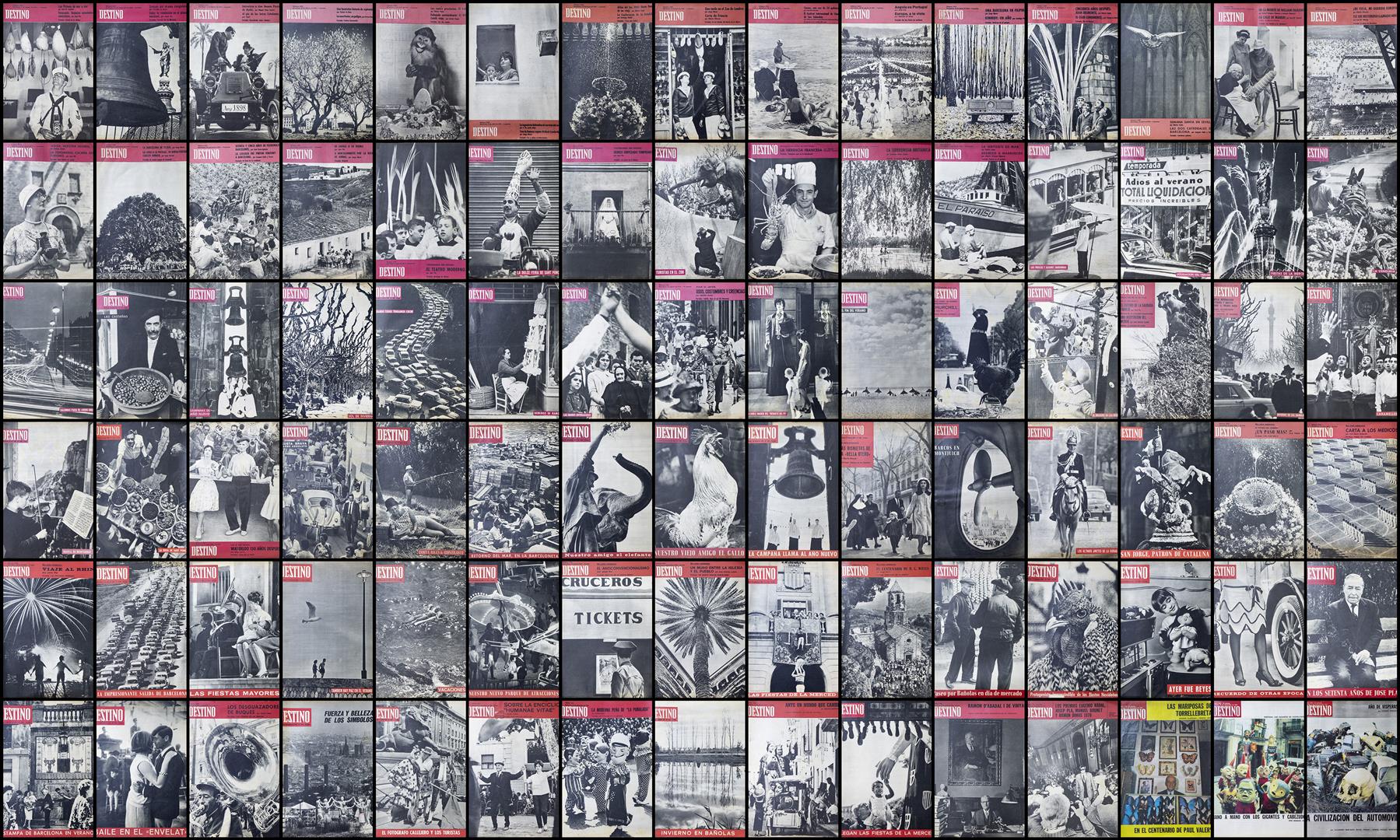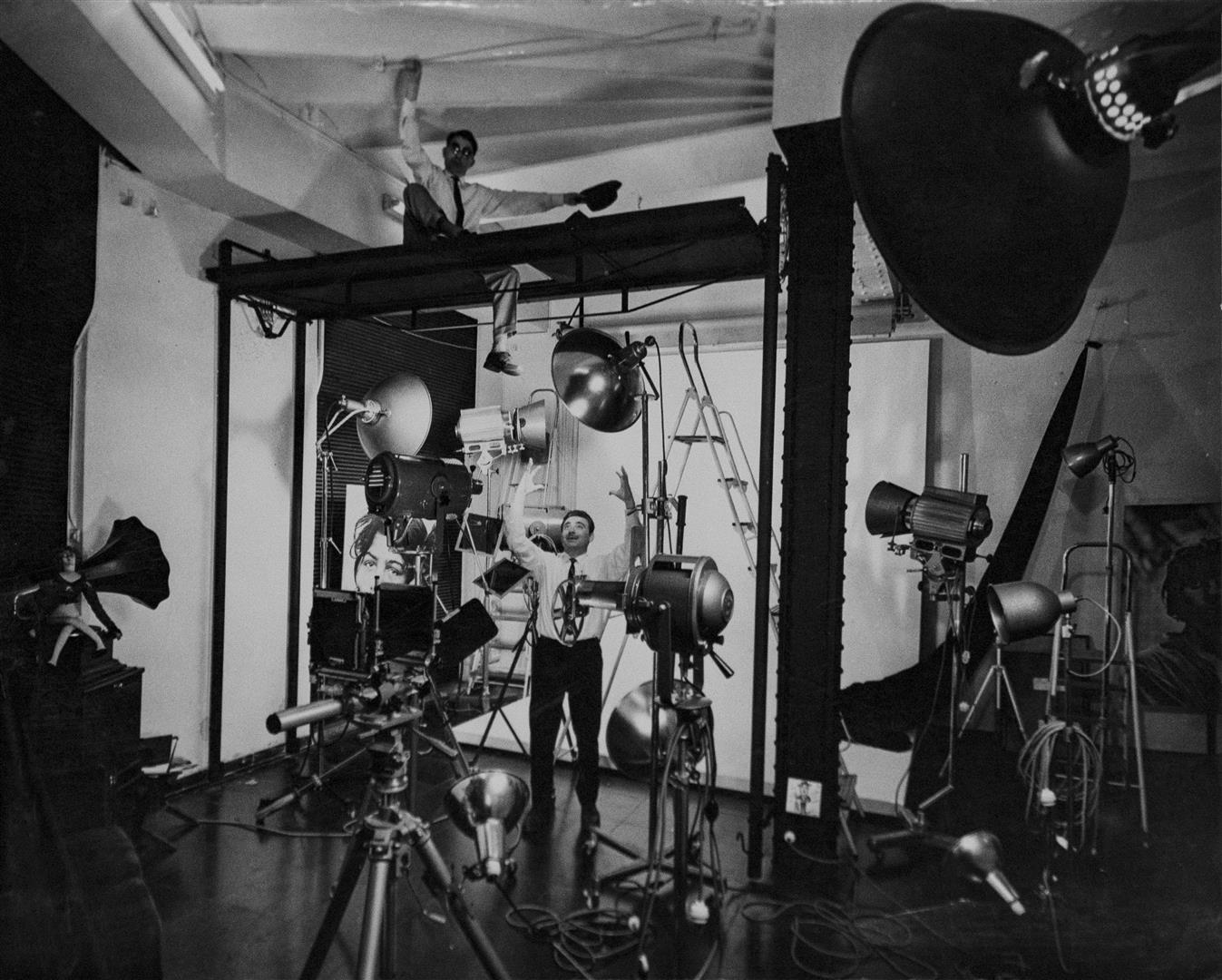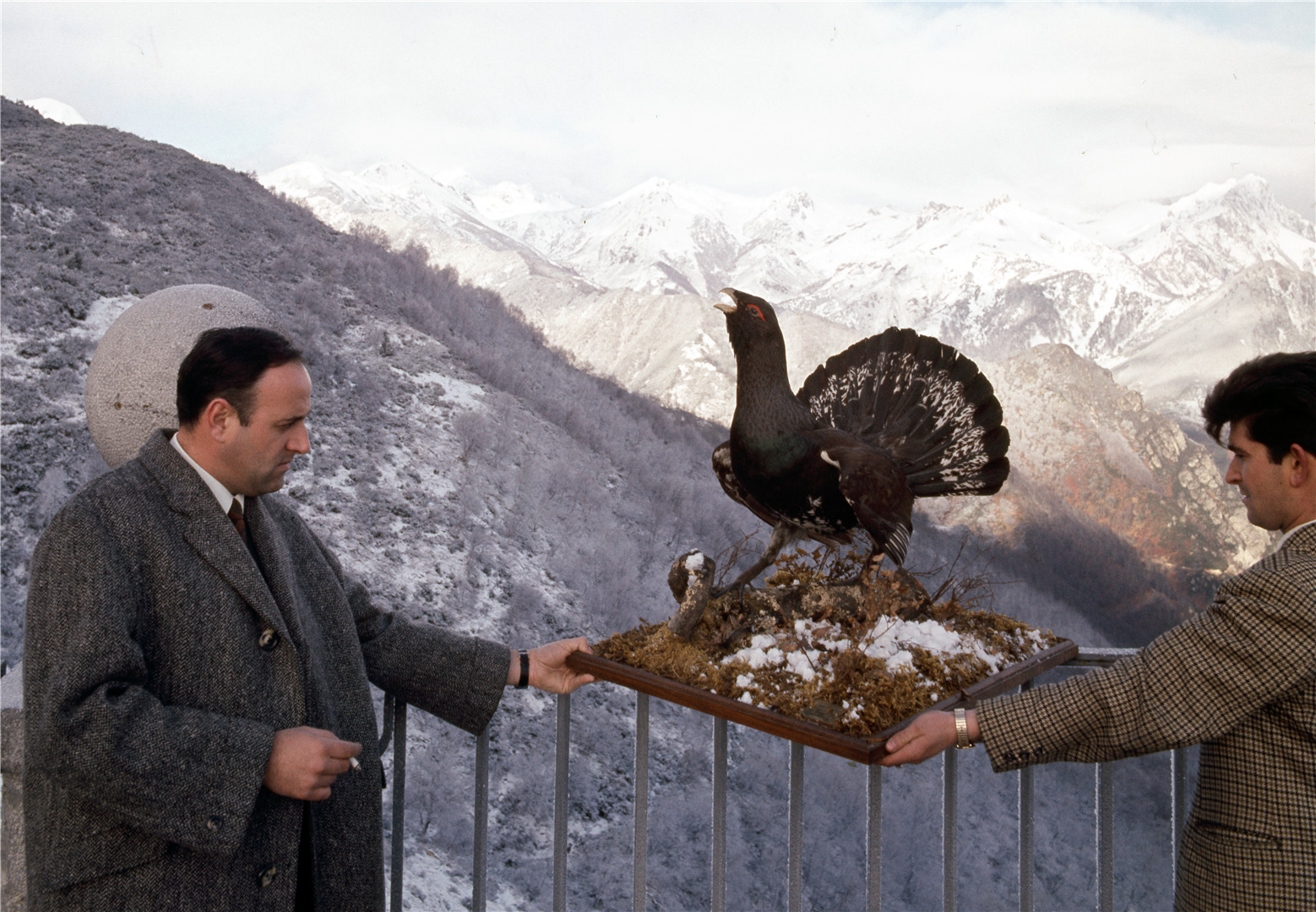Chronobiography
1926
Born in Barcelona on March 10, son of Josep Forcano and Rosa Andreu. He is the eldest of 12 siblings in a deeply religious family.
1940
He spent his childhood and youth in Canet de Mar (Barcelona). At a very young age he was already fascinated by photography; every day he would stop to contemplate the storefront of photographer Manuel Paratge, on Prat de la Riba Street, in Canet de Mar. He took his first snapshots with a wooden camera that belonged to his mother.
1946
He sets up his first photographic laboratory in Canet de Mar (Fotografía Forcano), making reports of local life. However, before starting his career as a professional photographer Eugeni works as a "freelance salesman" linked to the textile industry "Can Maynou" in which his father was the manager. It was a fabric and canvas factory from which Forcano obtained the necessary material to create his own store "Forcano Creations and Fantasies”.
1949
His growing interest in photography leads him to become a member of the Agrupació Fotogràfica de Catalunya, to which he will belong throughout his life.
1950
In the early 50's Eugeni Forcano founds "Transportes Catedral" (Calle Joaquim Pou, 4 in Barcelona), a company dedicated to home delivery (Delibery or Globo have not invented anything new!). As in the case of the accessories store, the company achieves a remarkable commercial success, working for famous people, such as the cupletista Raquel Meyer or the aeronautical company "Aviaco".
1959
He bursts into the world of photography and takes part in international exhibitions - where he obtains important prizes - as well as in national competitions.
1960
He begins to work for the weekly magazine Destino, for which he will make covers and reports as a permanent collaborator until 1974.

In collaboration with his brother Josep, he creates "Studio Forcano" (in Joaquim Pou Street, 4, where Transportes Catedral had previously been). Josep will be his faithful collaborator for nearly two decades.

1962
As an advertising photographer, he began his activity at Roldós. He was immediately called by Seix y Barral Publicidad. This led the same publishing house to commission him to create covers for the Biblioteca Breve and the Formentor collection. He also created covers for Editorial Aymà. He traveled to Paris at the invitation of the French General Commissariat of Tourism, as part of a group of Spanish photographers composed of Cualladó, Cantero, Gómez, Basté, Colom, Cubaró, Masats, Maspons, Miserachs and Ontañón, who later exhibited, also collectively, in Paris, Madrid and Barcelona, under the title Eleven photographers in Paris.
1963
Awarded the City of Barcelona Prize for black and white photography. Began working for France Press and Dalmas.
1964
Publication of the third edition of the book "Barcelona" by Editorial Destino, with 500 photographs of the city and texts by Carles Soldevila. He joined the artistic and technical team of the magazine Don (Fabra, Marquesans, Comín and Forcano) with the collaboration of Nèstor Luján, Joan Perucho, Josep Maria Espinàs, Jaime Gil de Biedma and Juan Marsé. Don was an unusual and daring way of making images and writing.
1966
Gebrauchgraphik International devotes an extensive section to him with an extensive commentary on his work. Graphis, Zurich, reproduces photographs of his work.
1967
Photographis, Zurich, published his most notable images. Commissioned by the Egat publishing house, he produced the first photographic poster within the artistic and cultural movement known as Tuset Street, together with graphic artists Gallardo, Vellvé, Pla Narbona, Parragón and Pedragosa.
1968
He was hired by Josep Maria Riba to take photographs for Tilsa (Textil Industrial Leonesa, S. A.). For two years he traveled to León to photograph the fashion collection that the creative team designed.

1969
The book "Festa Major" (Editorial Destino) containing his photographs and texts by Josep Maria Espinàs, was released. He worked for Publinsa, Keiton & Eckardt, Delpire (Paris) and Dupont (Switzerland).
1970
Received the Gold Medal of the Agrupació Fotogràfica de Catalunya for his work (color slides). Awarded the Gardoqui Prize for advertising, for his color work for Myrurgia.
1971
Awarded the Gardoqui Prize of publicity, for his originals in Spanish magazines for the Warner's brand. The FAD (Fomento de las Artes Decorativas) of Barcelona chose him as a photographer for a series of conferences on various subjects, with Daniel Giralt Miracle, Oriol Bohigas, Yves Zimmerman, Miquel Porter-Moix, etc.
1972
He designed the poster for the Semana Internacional de la Tercera Edad (International Senior Citizens' Week), which he did again in 1973 and 1974.
1974
He was awarded the extraordinary Gold Plaque trophy of the Agrupació Fotogràfica de Catalunya for his creative career.
1975
He designed the poster for the Certamen Internacional de la Moda Masculina (International Men's Fashion Contest).
1976
Awarded the City of Barcelona Prize for color photography.
1978
The International Federation of Photographic Art, in Bern, named him FIAP Artist. Worked for the Mallorca exhibition-tribute to Joan Miró's 85th birthday, in direct collaboration with the painter.
1979
Appeared the 36th volume of the Complete Works of Josep Pla, published by Editorial Destino, in which the writer makes notable reference to his photographs. He designed posters for the exhibitions at the Sala Gothsland in Barcelona, and continued doing so in successive years.
1981
He was the only photographer in the "Exhibition of Posters of the Real Club de Tenis de Barcelona", organized by the Catalan Association of Advertising and Communication.
1983
Appeared "Història de l'art català" (L'època de les avantguardes 1917-1970), by Francesc Miralles (Edicions 62), in which he was highlighted as a photographer.
He received the Negracolor Grand Prize for a work resulting from his research on the photographic image.
1984
Dr. Josep Ramón Armengol dedicated a room in the Quirón Clinic in Barcelona to him as a permanent exhibition of his photographs. Forcano presented his work about a new way of creating images, "provoking chance through light" to a group of Spanish intellectuals (José Luís Aranguren, J.L. Sampedro, J. M. Lozano, Lluís Folch i Camarasa, J. M. Forcada, Alfredo Rubio de Castarlenas, etc.).
The Noticiero Universal echoed the event and Rosario M. Rochina, photography columnist, wrote: "This is not just another achievement in the revolutionary work of Eugenio Forcano, but an important conquest of photography in general. We are in a position to affirm that nothing similar has yet been produced at the international level". In volume 45 -the last one- of the Complete Works of Josep Pla, his photographs were published. One of these, "Portrait of farewell" of Josep Pla, symbolic and expressive, served as the cover of the book.
1985
He is awarded the Negtor-84 Grand Prize for color photography. Lluís Permanyer, writer and journalist, published in La Vanguardia, with color illustrations of remarkable format, an analytical and profound commentary on this new photographic language: "...which undoubtedly opens a horizon of enormous possibilities". And he also said, "The Barcelona photographer Eugeni Forcano has invented a new form of photographic expression". The magazine Diorama, of Madrid, published numerous images of Eugeni Forcano's new creativity, and its director, J. R. Alcocer, wrote: "...driven by his investigative spirit and the feeling that photography represents an open path towards the future, has generated that his work has been advanced in time and that we do not hesitate to qualify it as more in line with the feeling that we sense will prevail in the next 21st century.
1986
El Periódico de Catalunya published a report-interview about his life and work in his unique studio, in which his new photographs were also highlighted.

"Aquí Imagen", a magazine published in Madrid, dedicated a large and very prominent space to him, echoing his new photographs. The great connoisseur Jorge Rueda wrote: "... I look at you with amazement, Eugeni. You are so alive in your sixties that, at last, you have managed to photograph the sighs... You have spent so much time chasing the lights that you deserve to continue being a pioneer".
1987-1994
He recovered his black and white works and continued investigating, in ascending evolution, the new way of expression he had discovered.
1995
Special guest in the great exhibition "Retrat de Barcelona" at the Centre de Cultura Contemporània de Barcelona.
1996
Editorial Ausa published the book "Josep Pla vist per Eugeni Forcano", with very favorable reviews, and some comments such as: "... the most complex and penetrating portrait that has been bequeathed to us about that character" (Lluís Permanyer, La Vanguardia); " Seeing these photos is recovering the personality of Josep Pla" (Rosario Martínez Rochina, Diorama); "Eugeni Forcano is one of the best Catalan photographers of this century, along with Francesc Català-Roca and Xavier Miserachs, among a not so long list" (Dolors Massot, ABC); "A remarkable photography lesson" (José Corredor-Matheos, poet, critic and historian). Miquel Riera spoke extensively about the book and the author in El Punt and Presència. He was highlighted as an author in the exhibition "Fotografía y sociedad en la España de Franco. Fuentes de la memoria III" (Ministry of Culture, La Caixa, Lunwerg), as well as in the book derived from it.
1997
Exhibition in the Gallery Pièce Unique -Josep Gich of Palafrugell: "A la sombra seductora de Josep Pla", within the commemoration acts of the centenary of the great writer. Exhibition of original works and presentation of the book "A la sombra seductora de Josep Pla" (Ediciones Polígrafa) at the Joan Prats Gallery in Barcelona. The exhibition toured Catalonia. Participated in the tribute to Josep Pla in Ceret (France) with black and white photographs of the writer.
1999
Publication of the book "Banyoles en dia de mercat, 1966", published by the Caixa de Girona Foundation. Presentation of the book and photographic exhibition in the historical hall El Tint in Banyoles, a cultural and civic event. The exhibition and the book later visited the Fontana d'Or in Girona and other towns in the province. Josep Pla wrote in 1966 in the magazine Destino: "In these photographs there is one thing that impresses me vividly, and that is that just by looking at them for a moment you can guess with great accuracy the dialogues that people establish". "The book is beautiful and a lovely testimony, not to history, but to life," writes Andrés Trapiello. Josep Maria Espinàs wrote in El Periódico: "You can hear these men and women of Banyoles speak".
2001
Exhibition at Kowasa Gallery in Barcelona of his black and white work. About it Juan Bufill wrote in La Vanguardia: "Fortunately, in Forcano's gaze there is, in addition to social denunciation and compassion, a healthy sense of humor". Abel Figueres wrote in Avui: "...images full of tenderness, humanity and vitalism... life can be caught on the fly if we have the sensitivity, wisdom, patience and the right technique".
2003
Kowasa Gallery presented Eugeni Forcano's photographs in "Paris Photo 2003", at the Carrousel du Louvre, along with other Spanish artists (Carlos Barrantes, Agustí Centelles, José Ortiz de Echagüe, Otho Lloyd, Ramon Masats, Oriol Maspons and Pilar Pequeño).
2004
The exhibition "La vitrina del fotògraf", at the Palau Robert in Barcelona, showed his entire artistic career. He participated in the exhibition "Private Lives" -with photographs from the collection of the Foto Colectania Foundation-, of which an extensive catalog was published. He took part in the major exhibition and book "El pop español", at the Esteban Vicente Museum of Modern Art in Segovia, under the direction of Francisco Calvo Serraller and with the collaboration of Publio López Mondéjar in the photographic section.
2005
Under the sponsorship of the Institut de Cultura de Barcelona, a large anthological exhibition of his work was presented at the Palau de la Virreina, with enormous success among the public, critics and the media. Lunwerg published the book "Eugeni Forcano: fotografias 1960-1996", very well documented in both texts and images. Many positive opinions. Jorge Rueda, photographer and critic, wrote to Forcano: "Thank you for the blinding explosion of life that is your book". The Unió de Professionals de la Imatge i la Fotografia de Catalunya (UPIFC) named him honorary member and dedicated a full issue of their magazine to him. He participated in the Fifth Seminar on Photography and Journalism organized by the Fundación Santa María de Albarracín; projection of an audiovisual, talk and colloquium with Rosario Martínez Rochina. The event will be repeated in Blanquerna (Ramon Llull University) and several other cultural entities.
2006
Forcano has a prominent presence in the exhibition and book "Miradas paralelas - Fotografía Realista en Italia y España", Museu Nacional d'Art de Catalunya (MNAC).
2008
Exhibition "Provocar L'atzar a través de llum", his last stage of investigation with color, at the Agrupació Fotogràfica de Catalunya. The catalog was also published.
2009
Donation to the Arxiu Fotogràfic de Barcelona of 650 large format black and white originals, taken in the city of Barcelona during the sixties and vintage copies developed by the author. There were two simultaneous exhibitions of these photographs at Arxiu Fotogràfic and at the Sala Ciutat of the Barcelona City Council. The Plenary of the Barcelona City Council agreed to award him the gold medal of artistic merit "for his work as a photographer and researcher of photography, a work endowed with a penetrating, sensitive, passionate and ironic look that, for many years, from the magazine Destino illustrated the Catalan social and cultural reality and that from numerous publications has been testimony of the evolution of the city and the culture of Barcelona".
2010
Publication of the book "Eugeni Forcano: la meva Barcelona" by Lunwerg Editores. Exhibition of a collection of black and white photographs, within the program of the contest Festimage of Calella (Barcelona). In the context of the 10th Photography and Journalism Seminar in Albarracín (Teruel, Spain), public conversation with Gervasio Sánchez and Rosario Martínez Rochina. Audiovisual on the various facets of his work in both black and white and color photography.
2011
Inauguration of the "Espai Eugeni Forcano" at the Casa Museu Lluis Domènech, in Canet de Mar. A permanent room of the photographic work and a synthesis of what his studio was. At the same time a large collection was exhibited throughout the museum, on a temporary exhibition.
2012
The Generalitat de Catalunya awards him with the Creu de Sant Jordi, for "his significance as one of the most outstanding professional photographers of the second half of the twentieth century in Catalonia, classic and avant-garde at the same time. His images make up a valuable artistic and cultural legacy". The Ministry of Culture awarded him the National Photography Prize "in recognition of the extraordinary quality of his work, the durability of his images, his long career, highlighting his capacity for innovation and experimentation in photographic language".
2013
Donation to Canet de Mar of two new photographic collections: "Josep Pla seen by Eugeni Forcano" and " A seductive shadow of Josep Pla". Creative and symbolist images related to his literary work. The City Council of Villarquemado (Teruel) gives the name "Sala Eugeni Forcano" to the exhibition hall of the Casa de la Cultura. Photographic exhibition "La vida atrapada al vuelo" organized by the Provincial Museum of Teruel.
2014
Exhibition "Atrapar la Vida" at the Real Academia de San Fernando in Madrid, organized by the Subdirección General de Promoción de las Bellas Artes del Ministerio de Educación, Cultura y Deporte in collaboration with the Royal Academy. Included in the official section of PhotoEspaña 2014. Publication of the book-catalog "Eugeni Forcano - Fotografías: Atrapar la Vida", edited by the Ministry of Education, Culture and Sport.
2015
Exhibitions at the Centre d'Estudis Catalans of the University Paris-Sorbonne and at the Fundació Ave María in Sitges: "Eugeni Forcano, Paris 62/15". Exhibition "Atrapar la vida" at the Museum of Teruel, within the Teruel Punto Photo Festival.
2016
Exhibition "Forcano and the fashion of the 60's" at the Sala Industria in Canet de Mar.
2017
Exhibition "Forcano and the fashion of the 60's" at the Centre Cultural Calisay in Arenys de Mar. Exhibition "Banyoles dia de mercat" at the Museu Arqueològic de Banyoles. Exhibition "La vida atrapada al vuelo" at the Galerie Chateau d'Eau and the Cervantes Institute of Tolosa.
2018
Exhibition "La vida atrapada al vol" and "Provocar l'atzar a través de la llum "Palau Solterra at Fundació Vila Casas. Publication of the book-catalog "La vida atrapada al vol".
Eugeni Forcano i Andreu died on April 22 in Canet de Mar at the age of 92.